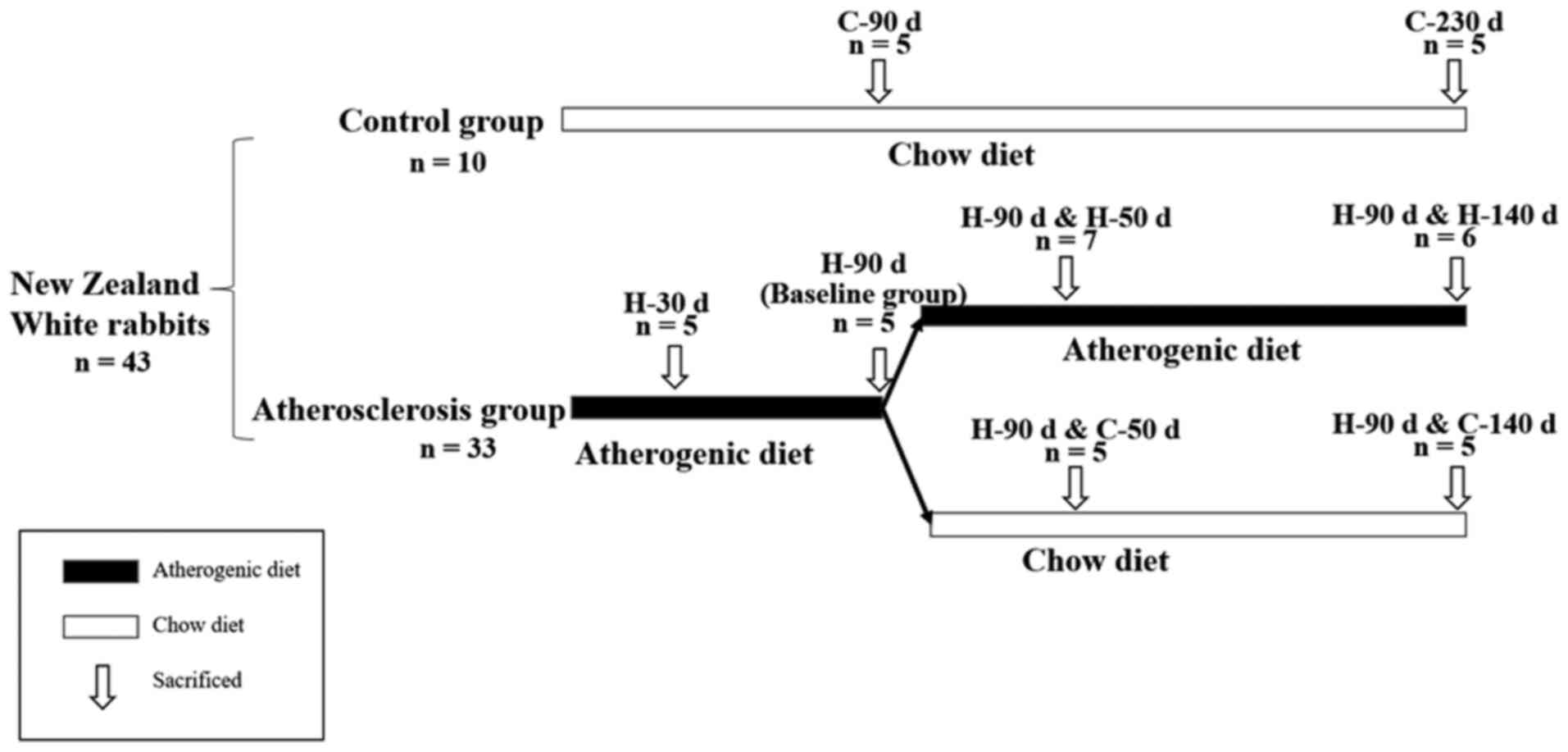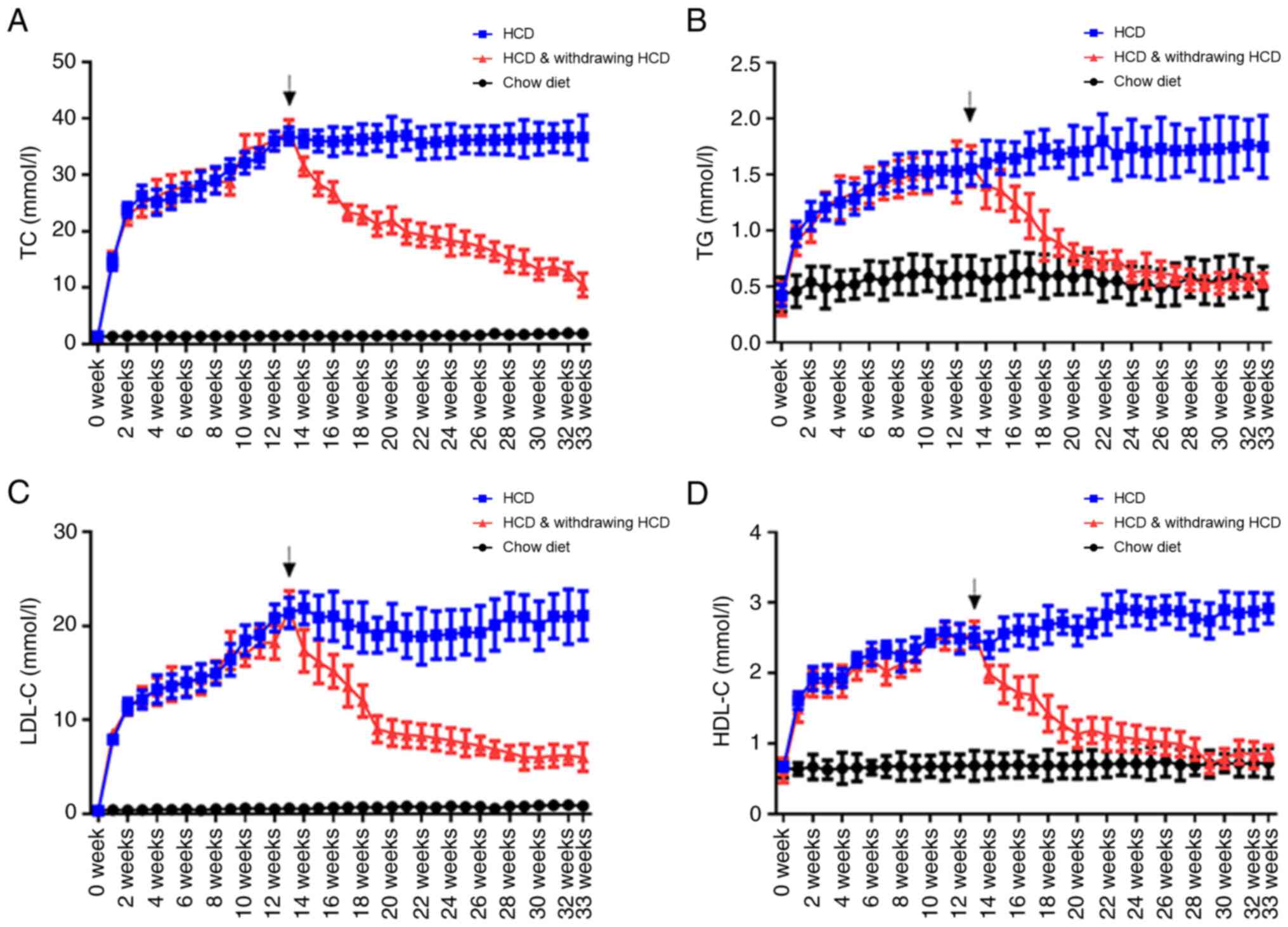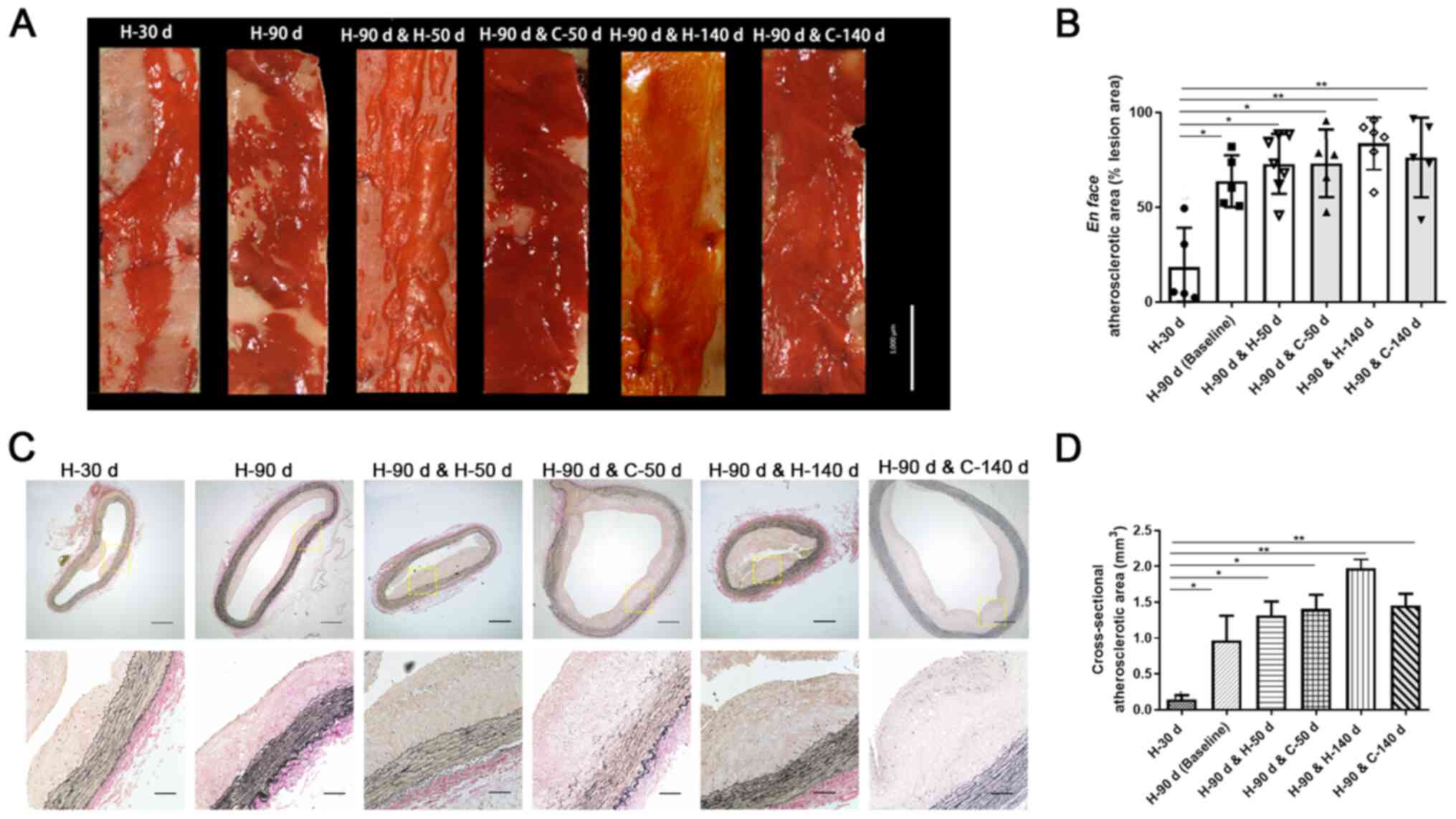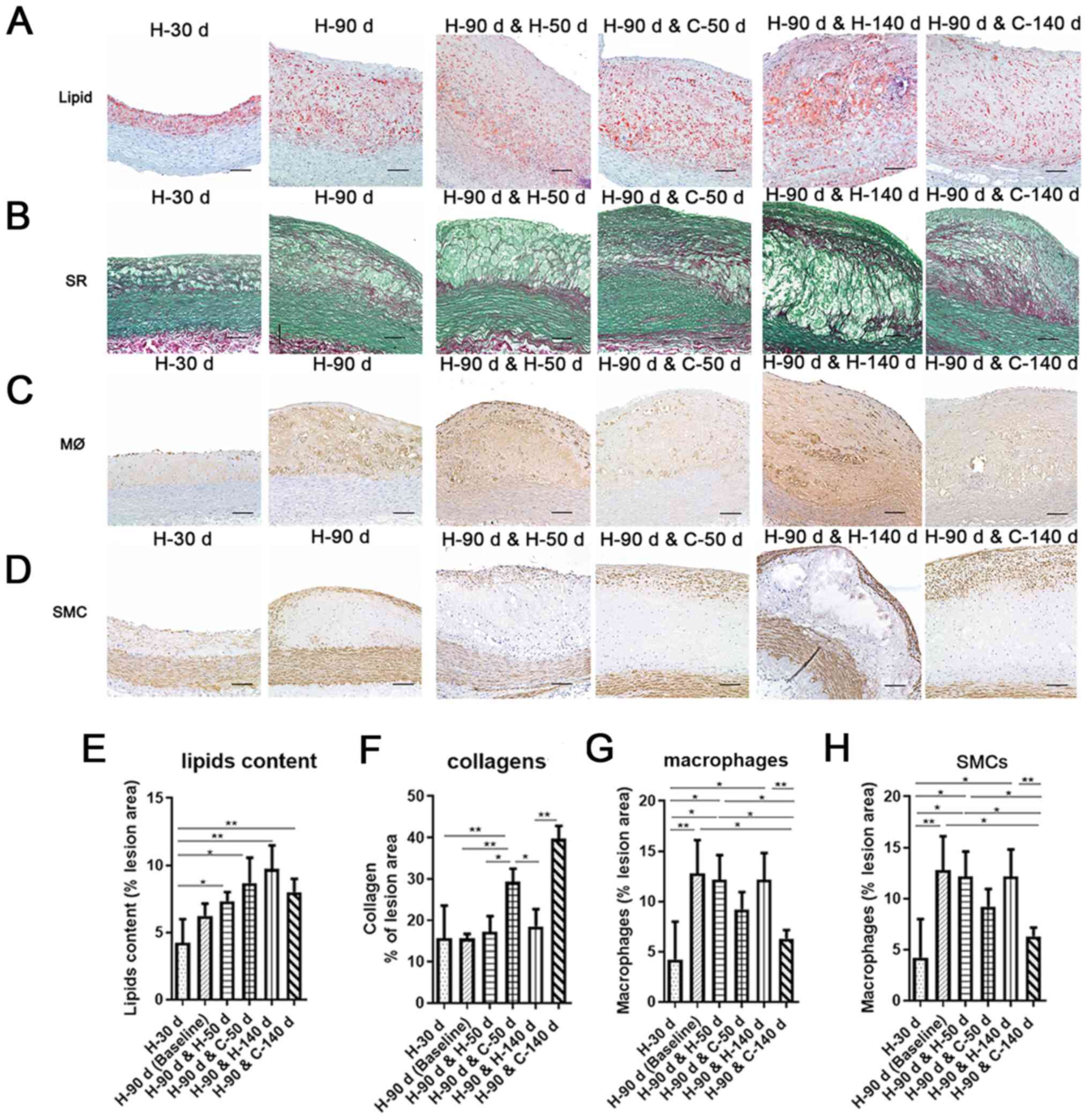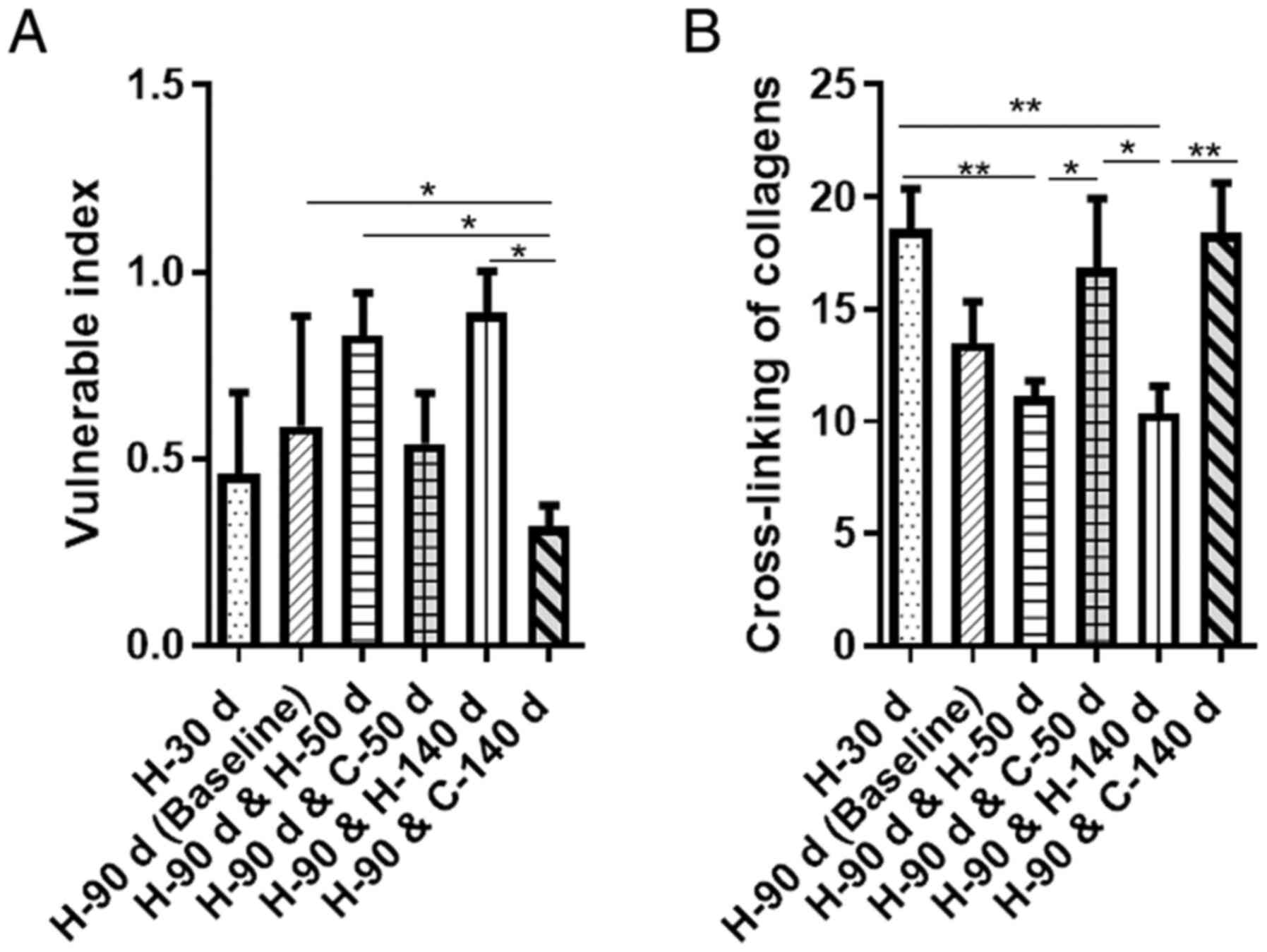|
1
|
Zhou M, Wang H, Zhu J, Chen W, Wang L, Liu
S, Li Y, Wang L, Liu Y, Yin P, et al: Cause-specific mortality for
240 causes in China during 1990-2013: A systematic subnational
analysis for the Global Burden of Disease Study 2013. Lancet.
387:251–272. 2016.PubMed/NCBI View Article : Google Scholar
|
|
2
|
Zhao D, Liu J, Wang M, Zhang X and Zhou M:
Epidemiology of cardiovascular disease in China: Current features
and implications. Nat Rev Cardiol. 16:203–212. 2019.PubMed/NCBI View Article : Google Scholar
|
|
3
|
Barquera S, Pedroza-Tobias A, Medina C,
Hernández-Barrera L, Bibbins-Domingo K, Lozano R and Moran AE:
Global overview of the epidemiology of atherosclerotic
cardiovascular disease. Arch Med Res. 46:328–338. 2015.PubMed/NCBI View Article : Google Scholar
|
|
4
|
Vigen C, Hodis HN, Selzer RH, Mahrer PR
and Mack WJ: Relation of progression of coronary artery
atherosclerosis to risk of cardiovascular events (from the
Monitored Atherosclerosis Regression Study). Am J Cardiol.
95:1277–1282. 2005.PubMed/NCBI View Article : Google Scholar
|
|
5
|
Bentzon JF, Otsuka F, Virmani R and Falk
E: Mechanisms of plaque formation and rupture. Circ Res.
114:1852–1866. 2014.PubMed/NCBI View Article : Google Scholar
|
|
6
|
Zhao LJ, Xiao Y, Meng X, Wang N and Kang
YJ: Application of a simple quantitative assessment of
atherosclerotic lesions in freshly isolated aortas from rabbits.
Cardiovasc Toxicol. 18:537–546. 2018.PubMed/NCBI View Article : Google Scholar
|
|
7
|
Goldberg IJ, Sharma G and Fisher EA:
Atherosclerosis: Making a U Turn. Annu Rev Med. 71:191–201.
2020.PubMed/NCBI View Article : Google Scholar
|
|
8
|
Chistiakov DA, Myasoedova VA, Revin VV,
Orekhov AN and Bobryshev YV: The phenomenon of atherosclerosis
reversal and regression: Lessons from animal models. Exp Mol
Pathol. 102:138–145. 2017.PubMed/NCBI View Article : Google Scholar
|
|
9
|
Ornish D, Brown SE, Scherwitz LW, Billings
JH, Armstrong WT, Ports TA, McLanahan SM, Kirkeeide RL, Brand RJ
and Gould KL: Can lifestyle changes reverse coronary heart disease?
The lifestyle heart trial. Lancet. 336:129–133. 1990.PubMed/NCBI View Article : Google Scholar
|
|
10
|
Aikawa M, Rabkin E, Voglic SJ, Shing H,
Nagai R, Schoen FJ and Libby P: Lipid lowering promotes
accumulation of mature smooth muscle cells expressing smooth muscle
myosin heavy chain isoforms in rabbit atheroma. Circ Res.
83:1015–1026. 1998.PubMed/NCBI View Article : Google Scholar
|
|
11
|
McConnell MV, Aikawa M, Maier SE, Ganz P,
Libby P and Lee RT: MRI of rabbit atherosclerosis in response to
dietary cholesterol lowering. Arterioscler Thromb Vasc Biol.
19:1956–1959. 1999.PubMed/NCBI View Article : Google Scholar
|
|
12
|
Aikawa M and Libby P: Lipid lowering
reduces proteolytic and prothrombotic potential in rabbit atheroma.
Ann N Y Acad Sci. 902:140–152. 2000.PubMed/NCBI View Article : Google Scholar
|
|
13
|
Haghjooyjavanmard S, Nematbakhsh M,
Monajemi A and Soleimani M: von Willebrand factor, C-reactive
protein, nitric oxide, and vascular endothelial growth factor in a
dietary reversal model of hypercholesterolemia in rabbit. Biomed
Pap Med Fac Univ Palacky Olomouc Czech Repub. 152:91–95.
2008.PubMed/NCBI View Article : Google Scholar
|
|
14
|
Maruffo CA and Portman OW: Nutritional
control of coronary artery atherosclerosis in the squirrel monkey.
J Atheroscler Res. 8:237–247. 1968.PubMed/NCBI View Article : Google Scholar
|
|
15
|
Armstrong ML, Warner ED and Connor WE:
Regression of coronary atheromatosis in rhesus monkeys. Circ Res.
27:59–67. 1970.PubMed/NCBI View Article : Google Scholar
|
|
16
|
Daoud AS, Jarmolych J, Augustyn JM and
Fritz KE: Sequential morphologic studies of regression of advanced
atherosclerosis. Arch Pathol Lab Med. 105:233–239. 1981.PubMed/NCBI
|
|
17
|
Wissler RW and Vesselinovitch D: Studies
of regression of advanced atherosclerosis in experimental animals
and man. Ann N Y Acad Sci. 275:363–378. 1976.PubMed/NCBI View Article : Google Scholar
|
|
18
|
Libby P, Bornfeldt KE and Tall AR:
Atherosclerosis: Successes, surprises, and future challenges. Circ
Res. 118:531–534. 2016.PubMed/NCBI View Article : Google Scholar
|
|
19
|
Armstrong ML: Evidence of regression of
atherosclerosis in primates and man. Postgrad Med J. 52:456–461.
1976.PubMed/NCBI View Article : Google Scholar
|
|
20
|
Aikawa M, Rabkin E, Okada Y, Voglic SJ,
Clinton SK, Brinckerhoff CE, Sukhova GK and Libby P: Lipid lowering
by diet reduces matrix metalloproteinase activity and increases
collagen content of rabbit atheroma: A potential mechanism of
lesion stabilization. Circulation. 97:2433–2444. 1998.PubMed/NCBI View Article : Google Scholar
|
|
21
|
Aikawa M, Sugiyama S, Hill CC, Voglic SJ,
Rabkin E, Fukumoto Y, Schoen FJ, Witztum JL and Libby P: Lipid
lowering reduces oxidative stress and endothelial cell activation
in rabbit atheroma. Circulation. 106:1390–1396. 2002.PubMed/NCBI View Article : Google Scholar
|
|
22
|
Ovchinnikova OA, Folkersen L, Persson J,
Lindeman JH, Ueland T, Aukrust P, Gavrisheva N, Shlyakhto E,
Paulsson-Berne G, Hedin U, et al: The collagen cross-linking enzyme
lysyl oxidase is associated with the healing of human
atherosclerotic lesions. J Intern Med. 276:525–536. 2014.PubMed/NCBI View Article : Google Scholar
|
|
23
|
Fan J, Kitajima S, Watanabe T, Xu J, Zhang
J, Liu E and Chen YE: Rabbit models for the study of human
atherosclerosis: From pathophysiological mechanisms to
translational medicine. Pharmacol Ther. 146:104–119.
2015.PubMed/NCBI View Article : Google Scholar
|
|
24
|
Emini Veseli B, Perrotta P, De Meyer GRA,
Roth L, Van der Donckt C, Martinet W and De Meyer GRY: Animal
models of atherosclerosis. Eur J Pharmacol. 816:3–13.
2017.PubMed/NCBI View Article : Google Scholar
|
|
25
|
Coscia L, Causa P, Giuliani E and Nunziata
A: Pharmacological properties of new neuroleptic compounds.
Arzneimittelforschung. 25:1436–1442. 1975.PubMed/NCBI
|
|
26
|
Gil AG, Silvan G, Illera M and Illera JC:
The effects of anesthesia on the clinical chemistry of New Zealand
White rabbits. Contemp Top Lab Anim Sci. 43:25–29. 2004.PubMed/NCBI
|
|
27
|
Ishikawa N, Kallman CH and Sagawa K:
Rabbit carotid sinus reflex under pentobarbital, urethan, and
chloralose anesthesia. Am J Physiol. 246:H696–H701. 1984.PubMed/NCBI View Article : Google Scholar
|
|
28
|
Lin Y, Bai L, Chen Y, Zhu N, Bai Y, Li Q,
Zhao S, Fan J and Liu E: Practical assessment of the quantification
of atherosclerotic lesions in apoE-/- mice.
Mol Med Rep. 12:5298–5306. 2015.PubMed/NCBI View Article : Google Scholar
|
|
29
|
Zhang WJ, Wei H and Frei B: The iron
chelator, desferrioxamine, reduces inflammation and atherosclerotic
lesion development in experimental mice. Exp Biol Med (Maywood).
235:633–641. 2010.PubMed/NCBI View Article : Google Scholar
|
|
30
|
Zhang C, Zheng H, Yu Q, Yang P, Li Y,
Cheng F, Fan J and Liu E: A practical method for quantifying
atherosclerotic lesions in rabbits. J Comp Pathol. 142:122–128.
2010.PubMed/NCBI View Article : Google Scholar
|
|
31
|
Liu XQ, Mao Y, Wang B, Lu XT, Bai WW, Sun
YY, Liu Y, Liu HM, Zhang L, Zhao YX and Zhang Y: Specific matrix
metalloproteinases play different roles in intraplaque angiogenesis
and plaque instability in rabbits. PLoS One.
9(e107851)2014.PubMed/NCBI View Article : Google Scholar
|
|
32
|
Napoli C, D'Armiento FP, Mancini FP,
Postiglione A, Witztum JL, Palumbo G and Palinski W: Fatty streak
formation occurs in human fetal aortas and is greatly enhanced by
maternal hypercholesterolemia. Intimal accumulation of low density
lipoprotein and its oxidation precede monocyte recruitment into
early atherosclerotic lesions. J Clin Invest. 100:2680–2690.
1997.PubMed/NCBI View Article : Google Scholar
|
|
33
|
Stary HC: Lipid and macrophage
accumulations in arteries of children and the development of
atherosclerosis. Am J Clin Nutr. 72 (5 Suppl):1297S–1306S.
2000.PubMed/NCBI View Article : Google Scholar
|
|
34
|
Nissen SE, Nicholls SJ, Sipahi I, Libby P,
Raichlen JS, Ballantyne CM, Davignon J, Erbel R, Fruchart JC,
Tardif JC, et al: Effect of very high-intensity statin therapy on
regression of coronary atherosclerosis: The ASTEROID trial. JAMA.
295:1556–1565. 2006.PubMed/NCBI View Article : Google Scholar
|
|
35
|
Stein EA, Mellis S, Yancopoulos GD, Stahl
N, Logan D, Smith WB, Lisbon E, Gutierrez M, Webb C, Wu R, et al:
Effect of a monoclonal antibody to PCSK9 on LDL cholesterol. New
Engl J Med. 366:1108–1118. 2012.PubMed/NCBI View Article : Google Scholar
|
|
36
|
Waksman R, Torguson R, Kent KM, Pichard
AD, Suddath WO, Satler LF, Martin BD, Perlman TJ, Maltais JA,
Weissman NJ, et al: A first-in-man, randomized, placebo-controlled
study to evaluate the safety and feasibility of autologous
delipidated high-density lipoprotein plasma infusions in patients
with acute coronary syndrome. J Am Coll Cardiol. 55:2727–2735.
2010.PubMed/NCBI View Article : Google Scholar
|
|
37
|
Nissen SE, Tsunoda T, Tuzcu EM,
Schoenhagen P, Cooper CJ, Yasin M, Eaton GM, Lauer MA, Sheldon WS,
Grines CL, et al: Effect of recombinant ApoA-I Milano on coronary
atherosclerosis in patients with acute coronary syndromes: A
randomized controlled trial. JAMA. 290:2292–2300. 2003.PubMed/NCBI View Article : Google Scholar
|
|
38
|
Rodrigueza WV, Klimuk SK, Pritchard PH and
Hope MJ: Cholesterol mobilization and regression of atheroma in
cholesterol-fed rabbits induced by large unilamellar vesicles.
Biochim Biophys Acta. 1368:306–320. 1998.PubMed/NCBI View Article : Google Scholar
|
|
39
|
Miyazaki A, Sakuma S, Morikawa W, Takiue
T, Miake F, Terano T, Sakai M, Hakamata H, Sakamoto Y, Natio M, et
al: Intravenous injection of rabbit apolipoprotein A-I inhibits the
progression of atherosclerosis in cholesterol-fed rabbits.
Arterioscler Thromb Vasc Biol. 15:1882–1888. 1995.PubMed/NCBI View Article : Google Scholar
|
|
40
|
Candipan RC, Wang BY, Buitrago R, Tsao PS
and Cooke JP: Regression or progression. Dependency on vascular
nitric oxide. Arterioscler Thromb Vasc Biol. 16:44–50.
1996.PubMed/NCBI View Article : Google Scholar
|
|
41
|
Elhage R, Maret A, Pieraggi MT, Thiers JC,
Arnal JF and Bayard F: Differential effects of interleukin-1
receptor antagonist and tumor necrosis factor binding protein on
fatty-streak formation in apolipoprotein E-deficient mice.
Circulation. 97:242–244. 1998.PubMed/NCBI View Article : Google Scholar
|
|
42
|
American Heart Association Nutrition
Committee. Lichtenstein AH, Appel LJ, Brands M, Carnethon M,
Daniels S, Franch HA, Franklin B, Kris-Etherton P, Harris WS, et
al: Diet and lifestyle recommendations revision 2006: A scientific
statement from the American Heart Association Nutrition Committee.
Circulation. 114:82–96. 2006.PubMed/NCBI View Article : Google Scholar
|
|
43
|
Malinow MR: Experimental models of
atherosclerosis regression. Atherosclerosis. 48:105–118.
1983.PubMed/NCBI View Article : Google Scholar
|
|
44
|
Feig JE: Regression of atherosclerosis:
Insights from animal and clinical studies. Ann Glob Health.
80:13–23. 2014.PubMed/NCBI View Article : Google Scholar
|
|
45
|
Aikawa M and Libby P: Lipid lowering
therapy in atherosclerosis. Semin Vasc Med. 4:357–366.
2004.PubMed/NCBI View Article : Google Scholar
|
|
46
|
Aikawa M, Voglic SJ, Sugiyama S, Rabkin E,
Taubman MB, Fallon JT and Libby P: Dietary lipid lowering reduces
tissue factor expression in rabbit atheroma. Circulation.
100:1215–1222. 1999.PubMed/NCBI View Article : Google Scholar
|
|
47
|
Meir KS and Leitersdorf E: Atherosclerosis
in the apolipoprotein-E-deficient mouse: A decade of progress.
Arterioscler Thromb Vasc Biol. 24:1006–1014. 2004.PubMed/NCBI View Article : Google Scholar
|
|
48
|
Peled M, Nishi H, Weinstock A, Barrett TJ,
Zhou F, Quezada A and Fisher EA: A wild-type mouse-based model for
the regression of inflammation in atherosclerosis. PLoS one.
12(e0173975)2017.PubMed/NCBI View Article : Google Scholar
|
|
49
|
Feig JE, Rong JX, Shamir R, Sanson M,
Vengrenyuk Y, Liu J, Rayner K, Moore K, Garabedian M and Fisher EA:
HDL promotes rapid atherosclerosis regression in mice and alters
inflammatory properties of plaque monocyte-derived cells. Proc Natl
Acad Sci USA. 108:7166–7171. 2011.PubMed/NCBI View Article : Google Scholar
|
|
50
|
Hafiane A: Vulnerable plaque,
characteristics, detection, and potential therapies. J Cardiovasc
Dev Dis. 6(26)2019.PubMed/NCBI View Article : Google Scholar
|
|
51
|
Zaman AG, Helft G, Worthley SG and Badimon
JJ: The role of plaque rupture and thrombosis in coronary artery
disease. Atherosclerosis. 149:251–266. 2000.PubMed/NCBI View Article : Google Scholar
|
|
52
|
Falk E: Pathogenesis of atherosclerosis. J
Am Coll Cardiol. 47:C7–C12. 2006.PubMed/NCBI View Article : Google Scholar
|
|
53
|
Adiguzel E, Ahmad PJ, Franco C and Bendeck
MP: Collagens in the progression and complications of
atherosclerosis. Vasc Med. 14:73–89. 2009.PubMed/NCBI View Article : Google Scholar
|
|
54
|
Martínez-González J, Varona S, Cañes L,
Galán M, Briones AM, Cachofeiro V and Rodríguez C: Emerging roles
of lysyl oxidases in the cardiovascular system: New concepts and
therapeutic challenges. Biomolecules. 9(610)2019.PubMed/NCBI View Article : Google Scholar
|
|
55
|
Li T, Wu C, Gao L, Qin F, Wei Q and Yuan
J: Lysyl oxidase family members in urological tumorigenesis and
fibrosis. Oncotarget. 9:20156–20164. 2018.PubMed/NCBI View Article : Google Scholar
|
|
56
|
Rodriguez C, Martinez-Gonzalez J, Raposo
B, Alcudia JF, Guadall A and Badimon L: Regulation of lysyl oxidase
in vascular cells: Lysyl oxidase as a new player in cardiovascular
diseases. Cardiovasc Res. 79:7–13. 2008.PubMed/NCBI View Article : Google Scholar
|
|
57
|
Baumgartner C, Brandl J, Münch G and
Ungerer M: Rabbit models to study atherosclerosis and its
complications-Transgenic vascular protein expression in vivo. Prog
Biophys Mol Biol. 121:131–141. 2016.PubMed/NCBI View Article : Google Scholar
|
|
58
|
Getz GS and Reardon CA: Animal models of
atherosclerosis. Arterioscler Thromb Vasc Biol. 32:1104–1115.
2012.PubMed/NCBI View Article : Google Scholar
|
|
59
|
Buchanan JR, Kleinstreuer C, Hyun S and
Truskey GA: Hemodynamics simulation and identification of
susceptible sites of atherosclerotic lesion formation in a model
abdominal aorta. J Biomech. 36:1185–1196. 2003.PubMed/NCBI View Article : Google Scholar
|
|
60
|
Sharif F and Murphy RT: Current status of
vulnerable plaque detection. Catheter Cardiovasc Interv.
75:135–144. 2010.PubMed/NCBI View Article : Google Scholar
|
|
61
|
Dong M, Zhou C, Ji L, Pan B and Zheng L:
AG1296 enhances plaque stability via inhibiting inflammatory
responses and decreasing MMP-2 and MMP-9 expression in
ApoE-/- mice. Biochem Biophys Res Commun. 489:426–431.
2017.PubMed/NCBI View Article : Google Scholar
|
|
62
|
Liang WJ, Zhou SN, Shan MR, Wang XQ, Zhang
M, Chen Y, Zhang Y, Wang SX and Guo T: AMPKα inactivation
destabilizes atherosclerotic plaque in streptozotocin-induced
diabetic mice through AP-2α/miRNA-124 axis. J Mol Med (Berl).
96:403–412. 2018.PubMed/NCBI View Article : Google Scholar
|
|
63
|
Shiomi M, Ito T, Hirouchi Y and Enomoto M:
Fibromuscular cap composition is important for the stability of
established atherosclerotic plaques in mature WHHL rabbits treated
with statins. Atherosclerosis. 157:75–84. 2001.PubMed/NCBI View Article : Google Scholar
|
|
64
|
Wang F, Chen FF, Shang YY, Li Y, Wang ZH,
Han L, Li YH, Zhang L, Ti Y, Zhang W and Zhong M: Insulin
resistance adipocyte-derived exosomes aggravate atherosclerosis by
increasing vasa vasorum angiogenesis in diabetic ApoE mice. Int J
Cardiol. 265:181–187. 2018.PubMed/NCBI View Article : Google Scholar
|
|
65
|
Burke AC, Sutherland BG, Telford DE,
Morrow MR, Sawyez CG, Edwards JY and Huff MW: Naringenin enhances
the regression of atherosclerosis induced by a chow diet in Ldlr
mice. Atherosclerosis. 286:60–70. 2019.PubMed/NCBI View Article : Google Scholar
|
|
66
|
Volgman AS, Palaniappan LS, Aggarwal NT,
Gupta M, Khandelwal A, Krishnan AV, Lichtman JH, Mehta LS, Patel
HN, Shah KS, et al: Atherosclerotic cardiovascular disease in South
Asians in the United States: Epidemiology, risk factors, and
treatments: A scientific statement from the American Heart
Association. Circulation. 138:e1–e34. 2018.PubMed/NCBI View Article : Google Scholar
|















